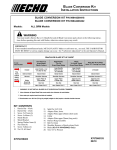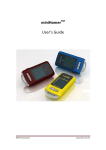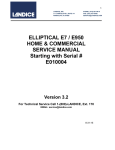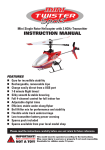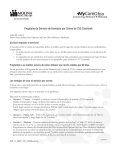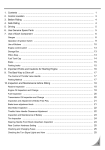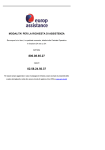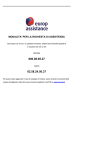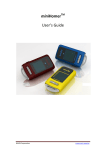Download Installation manual BMW E46 33 TS2
Transcript
Installation manual BMW E46 330 TS1/TS2 Technical support Europe: +4741558555 Technical support USA: (858)314-2954 Email support: support@esstuning Installation manual BMW E46 330 TS1/TS2 Remove and send ECU to ESS Tools required: - 5mm hexagon (Allen Wrench) or T20 Torx driver • Wait at least 5 minutes after turning off the car to perform this step to allow the ECU to discharge. The ECU is located under the plastic cover on the driver’s side of the car, just in front of the firewall (Pic.1). Remove the 4 bolts and lift cover towards fender. Start disconnecting the connectors from the fire wall side and towards the front of the car (Pic.2). Press the small tab and rotate the levers on the larger plugs to remove. Make a note of ECU type: MS43 or MS45 (Pic.3). • Be sure to include your name, address, phone number, and car and system with your ECU when you ship it. ECUs will be shipped back via FedEx GROUND unless you instruct us otherwise. Additional charges may apply for other shipping methods. US customers, please ship to our programming center: ESS Performance Products USA, Inc. 1900 W Chandler Blvd. Suite #15-242 Chandler, AZ 85224-6175 Telephone : (480) 389-4377 Fax: (602) 595-0486 (Phone hours : 9am-6pm MST) For customers outside the US only: -Fill in the missing info on the included pro-forma invoice and send the ECU to ESS Norway using UPS or FedEx. Do not mark the ECU with any higher value than 20USD. The address for customers outside the US: Company: Street: Zip: Town: Country: Phone: ESS Performance Products A/S Rive 1798 Aremark Norway 004741558555 1 Step 1: Remove microfilter housing, plastic cover around brake booster, cover in front of the windshield wiper motor and fuel injector cover. Tools required: - T30 torx driver - Flathead small screwdriver - 10mm socket • The microfilter housing sits above the engine against the firewall. Remove the microfilter housing cover by twisting the 3 clips (Pic.4) counter clockwise 1/4 turn. Remove the cover and the micro filter. Unclip the cover on the cable channel in front of the micro filter housing and pull the cables free (Pic.5). Loosen the four (4) x T30 Torx screws in the rear of the housing (Pic.6) and pull the housing up and out. • Remove the rubber insulation around the DME box by pulling straight up. Remove the twistlock right below the rubber insulation and to the right of the cable/hose grommets by rotating 1/4 turn counter-clockwise (Pic.7). • Pull the vacuum hose for the brake booster out of the rubber sealing on the brake booster. You will remove this hose together later with the intake (Pic.8). Pull the two cable/hose grommets up from the DME box side panel and pull the panel straight up and out. • Locate and remove the long panel that covers the AC blower/fan at the rear of the engine bay. There are two T30 Torx bolts securing the panel (Pic.9). Pull the panel a little out towards the front of the car and then straight up. This will be reused. 2 • Locate and unclip the two plastic clips using a flathead screwdriver on the injector cover (Pic.10). Unbolt the two bolts using a10mm socket (Pic.11). Remove the cover (Pic.12). All of these parts will be reused. 3 Step 2:Remove factory air filter box, mass air sensor (MAS/MAF/HFM) and rubber air intake all the way down to the throttle body. Tools required: - 10mm socket - 6mm flexible clamp tool - Pliers • Unbolt the two bolts holding the air filter box using M6/10mm socket (Pic.13). • Unclip the electrical connection for the mass air sensor (Pic.14). • Loosen the hose clamp that holds the rubber intake hose on the throttle body using a 6mm socket flexible clamp tool. • Pull the F connection out of the rubber intake hose (Pic.15). • Disconnect the wiring harness for the engine from the air filter box (Pic.16). • Pull the 3 push snaps holding the air intake for the air filter box that is located above the radiator using a pliers and/or a flathead screwdriver (Pic.17). • Remove the air filter box together with air intake, mass air sensor and rubber intake hose (Pic.18). • Disconnect the mass air sensor from the rubber hose. The air filter box and the Mass air sensor will be reused. 4 Step 3: Remove intake manifold. Tools required: -10mm socket -13mm socket -11mm socket -16mm socket -19mm socket -Flathead small screwdriver -Pliers • Locate the M8/13mm bolts holding the power steering reservoir tank. Unbolt them using a 13mm socket (Pic.19). Cut the clamp for one of the hoses going to the tank. Pull the hose and drain the tank (Pic.20). Make sure you don’t get any oil into the alternator. Keep the oil for reuse. When the tank is empty cut the other clamp and pull this hose off the tank also (Pic.20). Attach the stock hoses to the supplied ESS tank. Secure the hose clamps with pliers (Pic.21). Do not mount the tank back to the original position at this point. Just lay the tank aside on the inner fender for now. • Locate the fuel injectors. Each injector has a metal clip holding it to the wiring harness (Pic.22). Unclip each clip using a small flathead screwdriver and carefully pull the wiring harness away form the injectors. Unclip the electrical connection on the magnetic valve for the vanos (Pic.23) and the connection for the temp sensor on the intake manifold (Pic.24). Only MS43 type ECU cars have this sensor. MS45 cars do not have this sensor here. 5 • Unclip the O2 wiring connectors on top of the fuel rail (Pic.25). Lift the wiring harness up and lay it aside. • You can now see the 4 bolts holding the fuel rail. Remove these using a 10mm socket (Pic.26). Pull the fuel rail up together with the injectors. Follow the fuel hose on the back of the rail down under the intake and you will find it is clipped to the intake with a plastic snap. Unclip the hose from the intake and lift the fuel rail aside. You do not need to disconnect the fuel supply line (Pic.27). • Locate the dipstick tube. Pull the rubber hose off the connection on the lower part of the dipstick tube. Remove the 13mm bolt holding the dipstick tube in place (Pic.28). Now you can push the dipstick tube a little away from the intake manifold. • Squeeze the PCV quick connection on the valve cover and disconnect (Pic.29). • Slide the fuel tank ventilation valve off the manifold. LABEL and unclip the electrical connection. Disconnect the hose coming from the underside of the valve (Pic.30). • Locate and disconnect the positive battery cable feed to the starter above the right strut tower using a 19mm socket (Pic.31). 6 • Remove the three 10mm bolts (two bolts and 1 nut) holding the engine wiring harness brackets (Pic.32). LABEL and unclip all electrical connections that go to the intake manifold. This is for the throttle body (Pic.33), idle control valve (Pic.34), and DISA manifold valve (Pic.35). Pull the engine wiring harness away from the intake manifold (Pic.36). • The manifold is mounted to the car with 9 x M7/11mm nuts (Pic.37) around the intake runners and 1 x M10/16mm nut under the throttle body (Pic.38). Locate the nut under the throttle body and unbolt it using a 16mm socket. This nut can be difficult to get to and you may have to use extension and twist to get to it or approach it from under the car. Unbolt the manifold M7 nuts using an 11mm socket. This nuts will be reused to bolt the supercharge assembly in place in a later step. • Unbolt the plastic nut holding the positive battery cable feed to the starter on the intake (Pic.39). • Now you can lift the manifold a little off the engine. You will have to unclip the connection for the knock sensor from the metal holder (Pic.40). • Some models have two vacuum hoses connected to the back of the intake (Pic.41). This is for controlling the EGR (Exhaust gas regulations) valve and the exhaust flap in the rear muffler. Pull the hoses from the connections. These vacuum hoses will be reconnected to the new intake manifold. 7 • Cut the tie wrap on the back of the intake (Pic.42) and slowly lift the entire manifold away from the car. The positive battery cable feed to the starter has to move a little back and forth when you lift the manifold. Make sure all the connections are free when you pull the manifold out. Step 4: Prepare wiring harness for engine. Tools required: - Small flathead screwdriver - Electrical tape • Unclip all the small clips around the plastic box for the engine wiring harness (Pic.43). Split and remove the box (Pic.44). Use electrical tape to tape all the wires. You may need a little extra length for the wire going to the mass air sensor. Make a 50mm (2inch) cut in the ribbed rubber isolation. Pull the wires for the mass air sensor out from the cut and isolate with electrical tape (Pic.45) Secure the whole wiring harness to the water tubes below. Use supplied tie wraps to secure everything (Pic.46). It is very important that all the wiring are secured and does not move around on sharp edges or anything else that can cause problems. • The connection that used to go to the DISA will not be reinstalled. Secure the connector with electrical tape and tie wraps (Pic.47). 8 Step 5: Install aluminium idler bracket plate with spacers and pulleys. (ESS-M54-07) Tools required: - 16mm socket - 8mm hexagon socket (Allen Wrench) - Pliers - T25 Torx driver • To make enough room working on the belt system you will have to remove the fan assembly. There is one torx bolt (Pic.48) and one snap rivet (Pic.49) at the top holding the assembly in place. Use a T25 torx driver to remove the bolt. Use pliers to remove the snap rivet. Unclip the two electrical fan connections (Pic.50) and slide the entire fan assembly straight up and out (Pic.51). • Remove the belt for the AC compressor. This can be done by hand. Push the tensioner pulley between the AC compressor and the crank straight down and slide the belt off (Pic.52). • Locate the tensioner pulley for the main belt. It is the pulley that is located between the water pump and the alternator pulley. Some models have a 16mm head on the arm for the pulley. On this models use a 16mm socket wrench and release the pressure on the belt by pushing the wrench slowly clockwise. Use your free hand to slip the belt off. The other option on the tension is an 8mm hexagon bolt inside the pulley it self. Use a small screwdriver to pop the dust cover off the pulley (Pic.53). Use an 8mm hexagon tool and slowly release the tension by turning the tool clockwise. Use your free hand to slip the belt off (Pic.54). 9 • Locate and unbolt the two bolts holding the alternator using a 16mm socket (Pic.55). • Install ESS idler bracket (ESS-M54-07) with pulley and spacers in the alternator mounting holes. The spacers, pulleys and the bolts are preassembled to the bracket. The short spacer goes on the top hole. The top bolt is 130mm and also secures the top idler pulley. The long spacer goes on the lower 150mm alternator bolt (Pic.56). Secure the two bolts using an 8mm hexagon tool. The fan assembly will be installed back into the car towards the end of the install. You will need this space when you install the belts later on. Step 6: Remove upper radiator hose. Tools required: - Small flathead screwdriver • Cut the tie wrap holding the wiring in place around the radiator hose (Pic.58). • Locate the three clamps holding the upper radiator hose into position and unclip them using a flathead screwdriver. Remove the hose from the car. A little coolant water will be spilled when the hose is removed. 10 Step 7: Install ESS supplied plug on dipstick tube. Tools required: - Flathead screwdriver • Locate the free outlet on the dipstick tube (Pic.59) where you pulled off the hose earlier. Install the supplied ESS plug hose to seal off this opening. Secure the clamp using a flathead screwdriver (Pic.60). Make sure you don’t twist or bend too much on the dipstick tube. You might damage the O-ring that seals the tube down into the oil pan. 11 Step 8: Remove front bumper. (Only TS2 and above stages) Tools required: - Torx kit - 8mm socket - Phillips screwdriver - Pliers • Remove the undertray beneath the engine using a Phillips screwdriver for the bolts and pliers for the 3 plastic clips that holds the undertray (Pic.61). • Unbolt the 2 E14 torx bolts (Pic.64) and the bolt with 8mm heads in the inner fenders (Pic.63) The inner fenders are also mounted in 2 quick connections or 2 bolts with 8mm head on the underside (Pic.62). • When you have the bumper loose, slide it away about 20cm and disconnect the connections for the front fog lights and the horn (Pic. 65) on both sides. Caution: Be careful with the bumper when you lay it down. Lay it over a chair or a bench. It is very easy to scratch the paint if you don’t handle it with care. 12 Step 9: Install ESS front IC heat exchanger, hoses and pump. (Only TS2 and above stages) Tools required: - Medium Phillips screwdriver - Pliers - Flathead screwdriver - 13mm socket - 10mm socket - 5mm hexagon (Allen Wrench) - Drill and 6.5mm (¼ Inch) drill bit - Solder and soldering iron • Remove the plastic cover in front of the radiator. It is mounted in 4 plastic bolts / clips. There are two on each side near the head lamps (Pic.66). Remove the clips using a Phillips screwdriver and pliers. Pull the cover a little up and away from the car. • Now you will see 4 free bolts sitting on the frame in front of the radiator. The front heat exchanger element is installed on the two lower bolts (Pic.67). The front element comes preassembled, but you might have to loosen the bolts a little to make it fit. The two L shaped brackets are installed onto the free bolts (Pic.68 and Pic.69). Secure them with supplied ESS nuts and washers using a 13mm socket. Tighten all the bolts on the element assembly. 13 • Install the ESS pump on the bottom part of the left inner fender. (Air filter side of the car). Hold the pump in the position shown in the picture below. Mark up where the bracket holes will be drilled (Pic.70). Remove the pump and drill two 6.5mm (1/4inch) holes using a drill (Pic.71). Install the pump using supplied rubber mountings, washers and nuts (Pic.72). Secure the nuts using a 10mm socket. • Locate the indicated red/white wire inside the DME box (Pic.73). Tap into the wire and connect the long red pump wire with the fuse holder in one end using solder and soldering iron (Pic.74). The fuse holder is installed inside the DME box (Pic.75) Make a small hole in the rubber isolation for the wiring harness going into the DME box in the front (Pic.76). Pull the red wire through the hole and run it down to the pump (Pic.77). Connect the wire to the red wire to the red pump wire using soldering iron and shrink isolation (Pic.78). Connect the black wire to a ground under one of the bumper strut bolts (Pic.79). Make sure you have a solid connection to ground. Secure the wires using supplied tie wraps (Pic.80 and Pic.81) and tape all exposed wires. 14 • Connect the middle ¾ inch hose to the inlet side of the pump. The inlet is on the end of the pump (Pic.82). Route the hose up into the engine bay and lay it along the engine (Pic.83). Connect the shortest ¾ inch hose to the outlet (on the side) of the pump (Pic.84) and to the nearest connection on front element (Pic.84). Connect the last ¾ inch hose to the far connection on the front element (Pic.85). Route the hose under the head lamp and up into the engine bay (Pic.86). Lay it along the engine together with the first hose (Pic.87 and Pic.88). Secure the hoses using tie wraps (Pic.86 and 87). Tighten all clamps using a flathead screwdriver. 15 Step 10: Prepare fuel rail. Tools required: - Flathead screwdriver - Silicone spray • Fuel is extremely flammable and under pressure and will leak here. Wrap this connection in a towel to contain released fuel. Disconnect the fuel line hose going to the fuel rail. This is done by pushing the blue ring around the steel tube towards the hose (Pic.89) then pull the rail from the hose. Drain the remaining fuel inside the rail. • Unclip the 6 clips holding the fuel injectors using a flathead screwdriver (Pic.90). Pull the injectors from the rail (Pic.91). • Adjust the inlet steel tube on the rail according to the picture (Pic.92). This is easily done carefully by hand. Make sure the tube is not kinked and that the internal flow will not be reduced in any way. • Install the 6 supplied ESS fuel injectors (Pic.93). Use silicone spray on the O-rings to make the install easier. Push the injectors into position and install the metal clips by hand. Connect the fuel rail to the fuel hose and lay rail in the engine bay (Pic.94). 16 Step 11: Install supercharger with manifold and intake. Tools required: - T40 Torx driver - 10mm socket - 11mm socket - 13mm socket - 5mm hexagon (Allen Wrench) - Flathead screwdriver. - Pliers - Paper - Licker • On the original manifold we removed, locate the bolts holding the bracket for the idle control valve (ICV) and unbolt them using a T40 torx driver (Pic.95). Turn the valve around in the rubber mounting bracket (Pic.96 and Pic.97). Connect the matching hose that is preinstalled on the intake part to the small outlet on the idle control valve (Pic.98). Secure the bracket using the supplied bolts (Pic.99). Connect the 1” 90 degree hose to the free outlet on the idle control valve (Pic.100). The other end will be installed in a later step to the hose before the throttle body. The arrow on the idle control valve body will point in the direction of the intake when it is installed. Secure the clamps using a flathead screwdriver. • Pull the hose for the fuel ventilation valve from the original intake manifold (Pic.101). Connect it to the matching outlet on the underside of the intake part and secure the connection using the supplied hose clamp (Pic.102). 17 • Locate and cut the hose clamp for the brake booster hose on the original intake manifold (Pic.103) Connect the hose to the matching outlet next to the bypass hose on the intake part for the supercharger (Pic.104). • Unbolt the throttle body from the original intake manifold using a 10mm socket. It is mounted with 4 bolts (Pic.105). Bolt the throttle body to the intake part using the original bolts. Use Loctite Blue to seal and secure the bolts (Pic.106). The throttle body should be mounted with the electrical connection pointing up (Pic.107). • Locate the oil temperature sensor on the lower part of the oil filter housing (Pic.108). Remove the plastic cover on the connection for the sensor (Pic.108). This is done to make clearance towards the shaft for the supercharger drive pulley (Pic.109). • Clean the intake ports on the engine (Pic.110). It is very important that area around the ports is totally clean. After the ports are cleaned, use a vacuum cleaner and pressurized air to make sure there is no dirt in the intake ports. 18 • Install the supplied ESS intake gasket (Pic.111). Use the supplied Loctite blue on both sides of the intake manifold gasket. You have about 15-20min to get the charger into position an bolted to the head before the silicone start to dry. • Pull the positive battery cable feed to the starter up between runner number 5 and 6 of the new manifold (Pic.112) as you start the next step. • Lift the supercharger assembly into position. When you have about 100mm left to go, connect the harness to the idle control valve (Pic.113) and the lower ¾ inch intercooler hose for the cooling system (Pic.114) and secure the clamp using a flathead screwdriver. It is easier to connect this now instead of when the assembly is all the way down. Lower the intake into position onto the head bolts. Use the original nuts and tight them down using 11mm socket. Start with the one in the middle and then to the left and then to the right until all nuts are secured in the order Pictured (Pic.115). These nuts should be tightened with a torque wrench to 20-22ft/lbs. • Attach the electrical connection for the throttle body (Pic.116). • Reinstall and secure the bolt for the dipstick tube (Pic.117). 19 Step 12: Install vacuum hose for original fuel pressure regulator, exhaust flap actuator (if applicable) and EGR valve actuator (if applicable) to intake manifold • There are 2 vacuum hoses coming from the intake just next to the bypass valve. The upper hose is marked with org fuel pressure regulator. Connect this hose to the small vacuum hose that used to be installed into the F connection removed in a previous step (Pic.118). • The lower hose has a T connection. Both outlets are plugged by default from ESS (Pic.119). Not all cars have the EGR valve and exhaust flap installed. If the car has EGR, pull the rubber plug that is marked with EGR and connect the hose from the EGR valve (Pic.120). You may have to cut the end a little to make a tighter fitting (Pic.121). If the car has the exhaust flap, pull the rubber plug that is marked with exhaust flap actuator and connect the hose coming from the vacuum tank near the starter (Pic.122). You may have to cut the end a little to make a tighter fitting here as well (Pic.123). If the car has no EGR or exhaust flap, leave the hoses plugged. If the car has one or the other installed, just connect the hose for this and leave the other hose plugged. You can also use these connections for a optional boost gauge. 20 Step 13: Install fuel rail and fuel injector connections. Tools required: - 5mm hexagon (Allen Wrench) - Silicone spray • Spray the lower O-rings on the fuel injectors using silicone. Install the fuel rail with the injectors into position on the intake manifold. Secure the rail with the supplied spacers and bolts using a 5mm hex wrench (Pic.124) Use Loctite Blue to seal and secure the bolts (Pic.125). Carefully install injector wiring harness back into position (Pic.126). Make sure all the connections snap straight onto the injectors. Install the O2 senor wiring harness and mounting brackets back into original position on the fuel rail (Pic.127). • Connect the electrical connection for the Vanos (Pic.127A). 21 Step 14: Relocate wire for air temperature sensor and install air temp sensor on the new intake (MS43 ONLY) Tools required: - Electrical tape This step is not required on MS45 cars. Your MS type was noted in the first step. • Locate the intake air temp sensor installed in the original intake manifold (Pic.128). Push the clip on the side of the sensor and pull it out of the intake (Pic.129). Use a little silicone on the o ring and push it into the matching outlet on the intake part on the supercharger (Pic.130). • Unclip the plastic cover on the wiring harness for the injectors. Relocate the intake air temperature sensor wires according to (Pic.131). Isolate the wires using electrical tape. Connect the electrical connection on the temp sensor. Secure the wire using tie wraps (Pic.131). Step 15: Install hose for PVC (Positive Crankcase Ventilation). Tools required: - Knife - Flathead screwdriver • Pull the elbow connection out of the PVC hose on the original intake manifold (Pic.132). Connect it to original position in the valve cover. Adjust the length of the hose coming from the PVC valve on top of the intake for the supercharger (Pic.133) and connect it to the elbow (Pic.134). Secure the connection using supplied clamp. 22 Step 16: Install rear engine cover, brake booster hose, cover around brake booster and fuel valve. Tools required: - T30 torx driver • Reinstall the cover in front of the AC/heater blower at rear of engine. Secure the bolts using a T30 torx driver (Pic.135). • Reinstall the plastic cover around the DME box using the original twist locks. To make the install easier, you can cut a little off the corner according to the Picture (Pic.136) but it is not necessary. • Use a little silicone on the connection for the brake booster hose. Push the connection into the rubber sealing in the brake booster (Pic.137). • Reinstall the fuel ventilation valve hose to the valve (Pic.138). Connect the electrical connection (Pic.138). Use tie wraps to secure the valve. Make sure no hoses are bent or kinked. 23 Step 17: Install supercharger belt and belt for AC compressor. Tools required: - 16mm socket • Install the supplied ESS belt for the supercharger according to (Pic.139) and belt routing illustration. The procedure for the tensions assembly is the same as in step for removing the belts. Install the AC belt back into original position (Pic.140). Step 18: Install power steering reservoir and bracket for upper radiator hose. Tools required: - 10mm socket - 13mm socket • Remove the cap and mounting bracket from the original power steering reservoir. Use an 11mm drill and enlarge the holes in the mounting bracket. You will have to do this to be able to install the reservoir behind the pulley and all the way down towards the shaft from the supercharger. Install the mounting bracket onto the new supplied ESS reservoir installed in a previous step. One of the mounting spacers is 3mm shorter and this is used on the hole that is closet to the front of the car. Here is where the bracket for the upper radiator hose also is mounted (Pic.142). Adjust the bracket according to the Picture. (Pic.143). Secure the bolts using 13mm socket. Use the supplied spacers and bolts to mount the bracket to the original position (Pic.141 and Pic.142). These spacers are used to make clearance towards the supercharger shaft. • Refill the oil for the power steering. Install the original cap (Pic.143) and check that the hose bracket clears the supercharger belt and pulley. 24 Step 19: Install upper radiator hose and fan assembly. Tools required: - Silicone spray - T25 torx driver • Spray some silicone on the O-rings on the supplied ESS upper radiator hose to make the install easier. Push the quick connections into position (Pic.144). • Check for clearance towards the supercharger drive pulley. Remember that the hose will be a little bigger when the car is warmed up. • Reinstall the fan assembly. Make sure it slides into position in the bottom. Secure it on the top using the standard T25 bolt and snap rivet. Reinstall the two electrical connections (Pic.145). • Refill the engine coolant system with coolant until you have the correct level. 25 Step 20: Install the air filter box, mass air sensor and silicone sleeve from throttle body to mass air sensor. Tools required: - 10mm socket - Flathead screwdriver • Separate the air filter box with mass air sensor from the original rubber intake (Pic.146). Connect the hose coming from the idle control valve installed in a previous step to the 1inch connection on the supplied ESS silicone sleeve (Pic.147) • Connect the ESS silicone hose to the throttle body. Lower the air filter box into position and connect it to the ESS silicone hose (Pic.148) Connect the hose that originally was installed to the F connection (Pic.149) to the top outlet on the silicone sleeve (Pic.150). Tighten all hose clamps. • Install the two original M6 bolts for the air filter box and secure them using 10mm socket (Pic.151). • Connect the electrical connection for the mass air sensor (Pic.148) • Install the cover on top of the radiator using the original plastic clips (Pic.152) 26 Step 21: Fill supercharger with supplied ESS oil. Tools required: - 8mm hexagon (Allen Wrench) • Unbolt the hexagon bolt on top of the supercharger. Pour the pre-measured oil from the ESS supplied oil bottle into the charger (Pic.153) Reinstall and secure the bolt. Step 22: Install ECU. Tools required: - 5mm hexagon or T20 torx driver • Install the programmed ECU and the cover for the DME box (Pic.154 and Pic.155). 27 Step 23: Fill the coolant system for the intercooler. (only TS2 and above stages) Tools required: - Flathead screwdriver - Coolant Mixture w/ Funnel • Pull the top ¾” intercooler hose from the back of the supercharger inlet manifold. Fill the hose with coolant mixture (½ BMW coolant with ½ distilled water) until it pores out of the free connection on the inlet manifold (Pic.156) Push the hose onto the free connection. • Turn the ignition switch to position two (do not start). The water pump will now start and you can check for any fuel leaks around the rail and injectors. The sound from the pump should be a steady low sound. After you have run the pump for a few minutes, turn the ignition off. Pull the hose from the inlet manifold again and fill the hose up with coolant mixture until it pores out of the free connection on the inlet manifold. Push the hose onto the connection and secure the clamp using a flathead screwdriver (Pic.157). Turn the ignition to position two and let the pump run for a few minutes. Check for any leaks in the coolant system. Step 24: Start the car and check for leaks. • Start the car and let it idle. • Check for leaks around the new upper radiator hose, around the fuel injectors, at the connections for the servo oil reservoir and in the coolant system for the intercooler. Let the car idle for 30 minutes while checking for leaks. 28 Step 25: Reinstall fuel injector cover, micro filter housing with filter (and front bumper on TS2 and above systems). Tools required: - 10mm socket - Torx set - 8mm socket - Phillips screwdriver • If no leaks are found, reinstall injector cover (Pic.158), micro filter housing with micro filter (Pic.159), and front bumper (Pic.160) using previous bolts and clips. The install should look like this when you are finished (Pic.161). Drive the car soft for the first 100miles (160km). Always use 91 US/98 EU or higher octane fuel. If you have any questions during this install, please call or email ESS The oil used in the supercharger is Castrol 10W/60 TWS motorsport oil. The total amount in the charger is 1,2dl / 120ml of oil. The oil should be changed every 15000km/10000miles. Use an oil pump to suck all the oil out of the supercharger and refill the supercharger with 1,2dl / 120ml of oil. If the car has more than 60000km / 40000miles on the clock ESS recommends to change the fuel pump and fuel filter when the supercharger is installed. We also recommend changing the belt tension assembly when the supercharger is installed. This is to prevent any belt failures. Technical support Europe: +4741558555 •Technical support USA: (858)314-2954 •Email support: support@esstuning 29






























